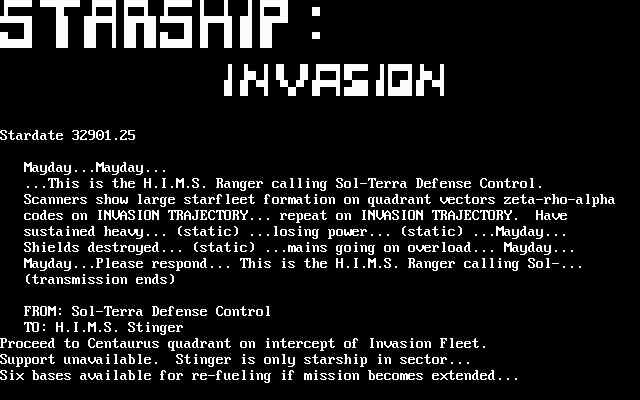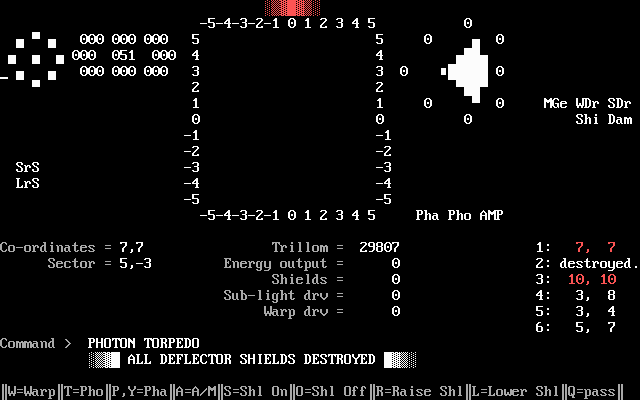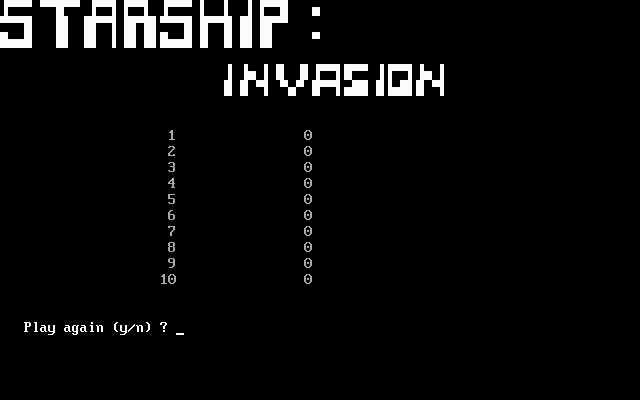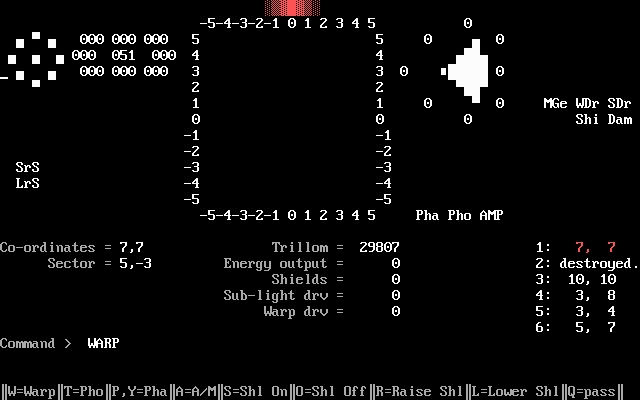Retro Replay Review
Gameplay
Starship: Invasion breaks from the methodical, turn-based tradition of early starship captain simulators by plunging players directly into real‐time engagements. Instead of pausing to contemplate every move, you must react instantly to rapidly changing threats—enemy fighters dart in from multiple vectors, energy levels fluctuate under fire, and shields can collapse in the blink of an eye. This design choice, championed by author George Moromisato, was intended to heighten tension and force snap decisions more akin to the pressure of actual combat command.
(HEY YOU!! We hope you enjoy! We try not to run ads. So basically, this is a very expensive hobby running this site. Please consider joining us for updates, forums, and more. Network w/ us to make some cash or friends while retro gaming, and you can win some free retro games for posting. Okay, carry on 👍)
The control scheme remains faithful to the classic BASIC‐derived interface: you have photon torpedoes, phasers, warp drive, and shield management at your disposal. However, these systems are governed by a “Trillom” energy resource that depletes with each action. Balancing offense and defense while conserving energy becomes an exercise in quick mental arithmetic, especially when enemy starships appear in waves of increasing difficulty. There’s no time to linger over menus—the moment an alert flashes, you must decide whether to divert power to shields or risk a torpedo salvo to thin your foes’ numbers.
Recharging at friendly StarDocks provides brief respites, allowing you to top up shields and Torpedo reserves, but these docks are prime invasion targets themselves. Six varieties of marauding enemy vessels—ranging from nimble scouts to heavily armored destroyers—vie for control of these outposts, forcing you to choose whether to defend your base or press the offensive. Each decision carries weight, as hesitating for even a few seconds can tip the balance of power. The real‐time pace ensures every encounter feels urgent and unpredictable.
Graphics
Given its early ’80s heritage, Starship: Invasion relies on minimalist visuals that lean heavily on text, ASCII‐style symbols, and a handful of color highlights. There’s a retro charm to the monochrome starfields punctuated by blinking cursors and numeric readouts. While it won’t rival modern pixel‐perfect renderings, the sparse graphics serve their purpose: conveying vital information quickly at a glance, without distracting from the core gameplay.
Weapon impacts and shield hits are represented by brief flashes or changes in color on your status panels. Phaser bursts appear as asterisks or hyphens streaking across the grid, while photon torpedoes are shown as trailing characters that converge on enemy ships. These simple effects create a sense of impact without overloading the small display. In many ways, this economy of visual design enhances immersion by focusing your attention on decision-making rather than spectacle.
Sector maps use a grid system with coordinate labels, allowing you to track multiple vessels simultaneously. Friendly StarDocks glow in green, enemies in red, and your ship in blue or yellow depending on its current energy level. Though rudimentary by today’s standards, this color‐coded approach ensures critical data is unmistakable even in the heat of battle. The result is a clear, functional presentation that feels authentic to the era and complements the game’s emphasis on swift, strategic action.
Story
While Starship: Invasion doesn’t feature an elaborate narrative campaign, it delivers a compelling premise through mission briefings and in‐game alerts. You assume command of the Excalibur‐class starship H.I.M.S. Stinger, tasked with defending vital StarDock installations from a relentless alien incursion. Each new wave of attacks brings a fresh challenge, whether it’s a surprise enemy formation or a direct strike on your base.
George Moromisato’s background in space exploration titles shines through in the thematic framing. Though the story is told through sparse text descriptors rather than cutscenes, you gain a strong sense of the stakes from the crisp mission statements and status updates. The minimalist approach leaves room for your imagination to fill in the cosmic backdrop of interstellar conflict, lending weight to every decision you make in real time.
Subtextual references to the systemic drawbacks of turn‐based simulations add an intriguing layer to the experience. By removing the comfort of extended deliberation, the game underscores the chaos of combat and the burden of command. This narrative undercurrent—of captains thrown headlong into unforeseen emergencies—turns each skirmish into a personal test of leadership and nerve.
Overall Experience
Starship: Invasion offers an adrenaline‐fuelled take on classic starship simulators, replacing methodical planning with split‐second choices that keep you on the edge of your seat. The real‐time mechanics may feel unforgiving at first, but they quickly become the game’s greatest strength, fostering a compelling loop of risk and reward. Every victory feels hard-won and every defeat a lesson in the perils of hesitation.
Despite its dated visuals and text‐based interface, the game retains enduring appeal for retro enthusiasts and strategy fans alike. The streamlined HUD and color‐coded alerts ensure that essential information is always in view, while the variety of enemy vessels and replayable scenarios mean no two sessions unfold identically. You’ll find yourself returning to defend StarDocks time and again, chasing the perfect run where energy management, tactical maneuvers, and timely reactions align just right.
Ultimately, Starship: Invasion stands as a bold experiment in capturing the chaos of deep‐space skirmishes. It may not boast cinematic graphics or sprawling lore, but its razor‐sharp focus on real‐time command challenges and its stripped-down aesthetic deliver a uniquely immersive experience. For players seeking a fast-paced, intellectually demanding starship simulator with a vintage flair, the H.I.M.S. Stinger is ready for launch.
 Retro Replay Retro Replay gaming reviews, news, emulation, geek stuff and more!
Retro Replay Retro Replay gaming reviews, news, emulation, geek stuff and more!








Reviews
There are no reviews yet.